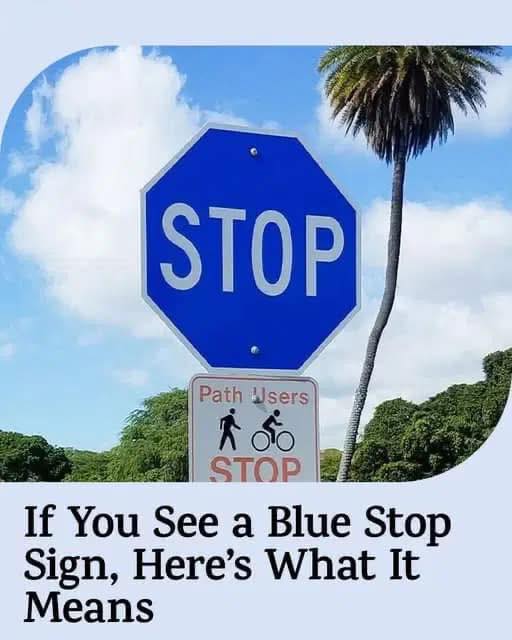Most drivers are familiar with the traditional red stop sign, a universal symbol that signals drivers to come to a complete stop before proceeding. From early childhood education to real-world driving experience, the red octagonal stop sign is ingrained in road safety culture. However, there are instances where a blue stop sign may appear, raising questions about its meaning and significance. While uncommon, these signs do exist in certain areas within the United States and internationally. But what exactly does a blue stop sign indicate, and where can you find one?

Understanding the Purpose of a Blue Stop Sign
In the United States, a blue stop sign still functions as an indicator that a driver must come to a complete stop before proceeding. These signs maintain the same octagonal shape as the traditional red stop sign, but they are not issued by federal or state transportation agencies. Instead, blue stop signs are primarily used on private properties and do not serve as official traffic control devices. Despite this distinction, their purpose remains the same—to control traffic flow and ensure safety.
According to the Federal Highway Administration’s Manual on Uniform Traffic Control Devices (MUTCD), all stop signs in the U.S. have been required to be red since the 1950s. The decision to standardize the color was based on red’s high visibility and its ability to be quickly recognized by drivers. This uniformity across the country makes stop signs instantly identifiable, reducing confusion and improving road safety.
While blue stop signs do not appear on public roads in the U.S., they are utilized in some other countries to indicate restricted access areas or no-entry zones.
Where Are Blue Stop Signs Found?
In the United States, blue stop signs are typically found in private areas such as large estates, ranches, private golf courses, or country clubs. These locations use blue stop signs to direct traffic flow within their property without violating traffic laws that regulate official signage. Hawaii, in particular, has a notable number of blue stop signs due to state regulations prohibiting official red stop signs on private property. Property owners in these areas use blue stop signs as a means to control internal traffic while complying with state regulations.
@.thenewwave♬ original sound – The New Wave
Internationally, blue stop signs can be seen in countries such as Japan, South Korea, and Mexico. However, their meaning differs from their American counterparts. Rather than signaling a standard stop-and-proceed rule, blue stop signs in these regions typically indicate restricted zones or areas where entry is not permitted. In these cases, a blue stop sign directs drivers to turn around and avoid proceeding forward.
Even in countries where blue stop signs exist, the red octagonal stop sign remains the global standard for traffic control. In 1968, the United Nations established international guidelines for road signage to ensure consistency across borders. The familiar red stop sign was included in these regulations, solidifying its presence as the primary stop directive worldwide.
Can You Install a Blue Stop Sign Near Your Home?
If you own a large private property with a network of roads, you may legally install a blue stop sign for internal traffic management. However, according to traffic regulations in the U.S., blue stop signs are not authorized for use on public roadways. In Massachusetts and most other states, only official traffic control devices may be installed on municipal or public roads. This means that while blue stop signs are permitted for private use, they cannot legally be placed on public streets.
Another important consideration is whether blue stop signs hold any legal enforcement power. Unlike red stop signs, which are universally recognized and enforceable by law, blue stop signs may not carry the same authority. Nonetheless, they serve a practical purpose on private roads and should be respected by drivers navigating these areas.
The Role of Blue Stop Signs in Traffic Management
The primary reason blue stop signs exist is to differentiate private traffic control from official government-issued signage. Because red stop signs are regulated and standardized, alternative colors such as blue allow property owners to implement their own traffic management systems without conflicting with legal road signs. Whether found on private land in the United States or used for specific traffic control in other countries, blue stop signs serve a distinct purpose in guiding vehicles safely.
Conclusion
While blue stop signs are not commonly seen on public roads, they still play a role in regulating traffic in private settings. In the U.S., they are primarily used on private properties such as estates, ranches, and golf courses, helping direct vehicles without conflicting with federal or state regulations. In some international locations, blue stop signs hold a different meaning, often signifying restricted access areas rather than traditional stopping points.
If you encounter a blue stop sign, it is advisable to treat it as you would any other stop sign—pause, check for oncoming traffic or hazards, and proceed only when it is safe. Although they may not carry the same legal authority as red stop signs, they are still installed with a specific purpose in mind. Understanding their function can help drivers navigate unfamiliar areas safely and efficiently, whether on private roads in the U.S. or restricted areas abroad.





